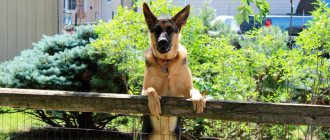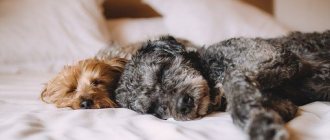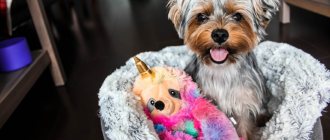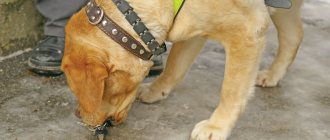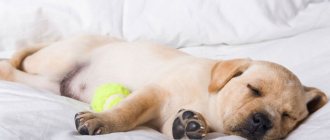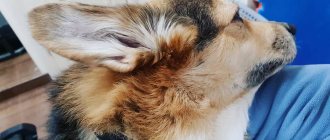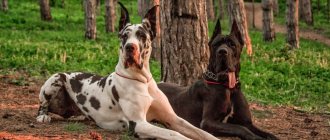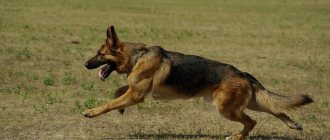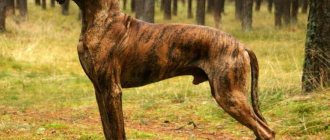History of the breed
The Breton Epagnole is a small pet that combines all the best qualities of dogs.
The breed received its name in honor of a province in France called Brittany. However, it is often called the British Espanol, considering that the dog is of English origin and is related to Great Britain.
In the Middle Ages, French farmers kept Hispaniole dogs to help them hunt and farm. Despite the fact that dogs of this breed were depicted on handmade tapestries as early as the 15th century, their official discovery is considered to be in 1850.
Important! The Spaniola is often called the Breton Spaniel, but this statement is incorrect.
The Breton Epagnole (French: épagneul breton) is one of the most popular breeds of gundogs in Europe and the USA! Breton Spaniels, as some call them, are intelligent and unobtrusive dogs with a very friendly nature that love to be socialized. Wonderful companions both on the hunt and at home. These are very hardworking and energetic dogs, indispensable assistants in field hunts. They love to import dead game from both land and water. An important advantage is that Bretons are perfect for living in an apartment, as they are the smallest representatives of pointing dogs! As the French say “ Un maximum de qualites pour un volume minimum ”, which translates to “ Maximum qualities with minimum volume ”!
Content:
1. History of the origin of the breed.
2. Appearance and physique.
3. Character.
4. Care and maintenance of the dog.
5. Education.
Working style: “shuttle” at high speed, at a distance of up to 100 meters in both directions.
Stance: high on the legs, muzzle directed at the hidden game.
Retrieval of game: innate. Serves both from sushi and water.
Coat type: long, wavy and smooth. There is no undercoat.
Color (FCI standard): basically white with splashes of red, chestnut or black. Gray hair and specks are allowed on the face, chest, and paws.
Height at withers: males - 45-52 cm, females - 43-51 cm
Weight: males - 15-19 kg, females - 15-16 kg.
Average life expectancy: 12-15 years.
Country of origin: France.
Origin of the breed: 17th century (found in paintings by Jan Havikzoon Sten)
History of the origin of the breed
The homeland of the breed is considered to be the province of Brittany, located in northwestern France; it was here, presumably in the 15th century, that these dogs were first mentioned. Hence the name of the breed - Breton Epagnole .
What does epanol ? Unfortunately, historians' versions are divided. Some believe that this means “ to lie ” in Old French, supposedly this is how the work of these dogs on the hunt was described, namely the manner of the cops to lie down next to the discovered bird so that the hunters would throw a net; others claim that Breton pointers are related to medieval Spanish bird dogs.
It is believed that the ancestors of the Breton Spaniel were medieval farm dogs designed to catch birds with nets. Unfortunately, there is no reliable information about the origin of the breed.
The first images of dogs similar to the Breton Epagnole are found on tapestries, as well as in paintings the 17th century by the Dutch painter Jan Havikzoon Steen .
Jan Havikzoon Sten “Happy Family”
And the first written descriptions of these wonderful hunting dogs date back to 1850 , thanks to the manuscripts of the clergyman Davis (“Memoirs of Hunting in Brittany”), who described in detail bird hunting using low, short-tailed dogs, whose hair was longer than that of pointers.
Since the end the 19th century, Breton pointers began to take part in dog shows. This breed received official recognition in 1907 , thanks to the efforts of the dog handler Arthur Enyud . Since 1900 , he worked hard to develop this dog breed, and then, 7 years later, presented his male dog named Boy . Later that year, he founded and headed the first club for breed lovers, the Club de l'Epagneul Breton, in the city of Loudéac.
On September 3 , 1908 , the first breed standard was adopted. However, due to the fact that Breton Spaniards are sometimes born tailless, the breed standard was adjusted in 1938 .
Many people call the Breton Spaniel a Breton Spaniel, most likely due to its external similarity and relationship with Springer Spaniels. But these are different dogs in terms of work style.
The Breton epañol was finally adopted by the FCI in 1954 under number 95 .
June 3 2010 , the All-Russian Canine Council decided to open an All-Russian stud book for hunting dogs of this breed.
Appearance and physique
The Breton Epagnole is the most compact representative of gundog dogs, strong, stocky, at the same time, neat and harmonious in build. Males at the withers can reach 52 cm, females - 51 cm. Body weight: males 15-18 kg, females - 14-15 kg. The proportions of the dog’s body are “square”, i.e. The height at the withers is equal to the length of the body. The head is well built and proportional to the body, the skull is slightly rounded in front and on the sides, longer than the muzzle (proportion 3:2 ). The top line of the head is parallel to the line of the muzzle. The muzzle is straight, with a wide nose, harmonizing in color with the overall color of the dog. The nostrils are large. The lips are thin and tight-fitting. The jaws are strong and well developed, with a complete dentition. The eyes are slightly round, not protruding. The eyelids fit tightly. The dog has a smart and kind look. The color of the iris is in harmony with the color of the body, usually brown. The ears are set high, hanging, triangular in shape, short and very mobile, the upper part is covered with soft wavy hair. The neck is strong and very muscular, of medium length. The back is short and straight, tightly connected to the sacrum. The withers are not prominent and mobile. The croup is slightly sloping and muscular. The chest is wide with rounded ribs. The stomach is tucked. The tail is short and straight, no more than 10 cm long, set high. The dog often wags it when it is active and attentive. It happens that the tail is missing from birth, this is not a disadvantage. The limbs are slender and muscular, parallel to each other. The hind legs are always longer than the front legs. The fingers are pressed together, the pads are dense, the claws are short.
The coat is smooth or slightly wavy, longer at the back than at the front. There is no undercoat.
The base color is white interspersed with red, chestnut or black. Gray hair and specks are allowed on the face, chest, and paws.
Character and work
The Breton Epagnole is a very sociable, energetic, strong and playful dog with a balanced character. Dogs of this breed are very loyal and, at the same time, unobtrusive and intelligent companions who love hunting. Thanks to his kind and playful character, he will become a favorite for all family members. But he is truly devoted to only one person - his master. The dog will get along well with children, as well as with other pets, as it does not strive for dominance. The only caveat is that it is best to accustom the Breton to other animals from childhood. It does not show aggression towards strangers, but treats them with distrust and caution, focusing on the owner’s reaction. Thus, the Breton is not suitable as a house guard.
In the field they are impetuous, hardworking, passionate and energetic, and are able to perfectly adapt to the wishes of the owner. An excellent pointing dog that excels at hunting all types of wild game. Works in the field at a fast pace (gallop) in a “shuttle” motion, for a distance of up to 100 meters in both directions. Having discovered a hidden game, the Breton freezes in a stance and patiently waits for the owner to approach, then raises the bird on its wing. They love to bring back dead game to their owner, both from land and water. This skill is in the Breton genes. Dogs work well in both heat and cold, but within reason. The dogs are very hardy, they can work in the field for 8-9 hours!
By the way, this breed of dog begins to work in the field very early and at the same time is able to show excellent results already at the age of 4-5 months, and at the age of 6-7 months it is already able to receive a diploma, which, you agree, is very good. They respond well to training.
By the way, these dogs really need communication and good physical activity. If the owner neglects this, the Breton may begin to act out in order to attract attention to himself or become depressed.
Dog care and maintenance
As mentioned earlier, the Breton is a compact dog and feels comfortable living in an apartment. In addition, these dogs are also clean and not smelly, so they should not cause much trouble in matters of order in the house. But you should not neglect regular and long walks (preferably 3 times a day) with good physical activity, as these cops are very active and energetic. Dogs love walks and, especially, hunting. If the dog does not walk enough and cannot fulfill its needs for physical and mental exercise, then it will become nervous and restless with destructive tendencies.
If you live in a private house, then do not put your pet in an enclosure, he will be extremely lonely there, he needs regular communication. Otherwise, the Breton may become depressed.
In other matters of maintenance and care, Breton epañol is unpretentious. It is advisable to comb the wool once a week, using slicker brushes, and during the molting period - more often, once every three to four days. It is not necessary to bathe your dog often, once every three months is enough, you can do it more often, but not more than once a month. Don't forget to use a good shampoo. Check and clean your ears once a week as they tend to become clogged with dirt. Also, check your eyes once a week and, if necessary, clean the area around the eyes. Monitor the condition of the claws; if they are not worn down effectively during walks, they need to be trimmed.
The health of this dog breed is good; Bretons are strong, strong and hardy. They have excellent immunity and are free from genetic defects. The predisposition to diseases is low, but the breed is characterized by: epilepsy, hip dysplasia, mammary gland cancer in bitches, seizures, and hypothyroidism.
Dogs need high-quality and balanced nutrition. If you prefer dry food, then it is advisable to purchase high-quality food, not lower than the super-premium .
If you want to feed your pet fresh and natural homemade products, it is recommended to include in the diet:
— meat: poultry , rabbit , beef and lamb ;
— seafood: lean fish , preferably without bones;
- cereals: buckwheat and rice , you can also offer oatmeal ;
- vegetables and fruits , both raw and boiled;
- fermented milk products, such as kefir , cottage cheese , cheese .
It is also necessary to control portion sizes, the fact is that Bretons have an excellent appetite and are prone to overeating, which can lead to problems with excess weight.
Upbringing
The Epagnole Breton is a very smart, intelligent and quick-witted dog. He is very trainable, quickly learns and remembers his owner’s commands. Has a high level of obedience and equanimity. Since these dogs mature early and are suitable for working in the field from the age of 4 months, training must begin as early as possible. But, during training, you need to be attentive and moderately demanding of the dog, be patient and do not forget that Bretons are very emotional dogs that can even be offended by a rude word! Therefore, you should not shout or threaten the dog, not to mention assault!
>Learn about other breeds of pointing dogs
You might be interested in:
Wild boar cutlets
I present to your attention a recipe for making juicy and tasty wild boar cutlets!
In order to prepare this delicious meat dish and please our family and friends, we will need the following ingredients: 1. Boar pulp - 1 kg. 2. Chicken egg - 1 pc. 3. Onions - 2 pcs. 4. White bread - 250 gr. 5. Garlic - 2 cloves. 6. Spices. 7. Salt. 8. Milk - 250 ml. 9. Vegetable oil - 50 ml. Read more…
Results of my 2021 hunting season
2018 hunting season has come to an end ; January 15, 1919 I handed in my season cards for game birds. Hunters must submit them within 20 days from the end of the hunting season to the hunting grounds where they were issued, otherwise they will face an administrative fine of 500 to 1,500 rubles.
This year I spent a lot of time on collective animal hunts for wild boar, deer and roe deer. Unfortunately, I did little hunting in the fields for birds and did not go hunting for fur game. Mostly due to lack of free time. There was a lot of work on weekdays, and on weekends, from October to the end of December, I went to collect hoofs. I will try to make up for the lack of field hunting next season.
Read more…
Hunting for the Crimean red deer, Ai-Petri 10/26/2019
The long-awaited Saturday has finally arrived, and that means it’s time to go wild! Today our team will hunt on the picturesque slopes of the Crimean mountains. These places are rich in red deer, as there are quite favorable conditions for its habitat: magnificent and spacious mountain yayls, rich in various herbs and mixed forests with good undergrowth. Thus, today our main hunting object is the Crimean red deer. Looking ahead, I’ll say that we had a successful hunt from the first drive!
Read more…
Share with friends!
Photo and description of the breed
Appearance of the dog according to the standard
The official current FCI Breton Spaniel standard was adopted on March 25, 2003. According to him, a purebred dog must have the following qualities:
- stocky and muscular build;
- the height of females and males at the withers is almost the same - from 46 to 52 centimeters;
- square body body;
- the back has a straight line;
- the rounded skull is located on a neck of medium length;
- oval eyes with the same shade as the coat color;
- short ears have a triangular shape;
- a large round nose lobe of the same shade as the eyelids;
- a straight tail is no more than 10 centimeters, but a docked tail is from 4 to 6 centimeters.
Description of the Breton Epagnole breed and photo
“Epanol Breton” - the name of the breed is pronounced in French with accents on the last syllables. Compact cops are real French. Low, tightly knitted, but graceful and light.
fci standard
The latest changes in the official description of epagnoles date back to 2003.
- Height at the withers : males - from 48 to 51 centimeters, females - from 47 to 50 centimeters.
- Weight : not regulated by the standard; proportions are more important for assessing an individual. Varies from 14 to 18 kilograms.
- Head : shaped like a shoe - a characteristic feature of epagnoles. Dry, proportional, with a smooth transition from forehead to muzzle.
- Eyes : oval, slightly slanted, dark in color. In individuals with light colors, warm shades are possible.
- Ears : triangular, set high, rather wide, but short. The top of the ears is covered with long hair.
- Nose : rather wide, large nostrils, color consistent with coat.
- Jaws : Scissor bite, compact dry lips. The upper lip overlaps the lower lip.
- Body : length corresponds to height at withers. The back is straight, the lower back is wide.
- Chest : very voluminous, up to half height deep.
- The stomach is tucked up.
- Limbs : with developed muscles, straight, the hind legs are noticeably longer than the front ones.
- Tail : straight, no longer than 10 centimeters.
- Coat : smooth, wavy, longer on the back of the body. There is no undercoat.
- Color : two-tone. The main background is white. Additional colors – black, brown, orange. Speckling is possible on the face, chest, forelimbs, and near the tail. Mark marks and a stripe on the forehead are welcome.
Reasons for disqualification
Disadvantages of the Epagnole, in which the dog is not allowed to show. For companions and hunters, exterior flaws do not matter.
- Straight bite, uneven teeth.
- Protruding eyes or a difference in their shape from oval.
- Short neck, dewlap.
- Lack of pigment on the nose or nostrils.
- The tail is longer than 10 centimeters.
- Short, equal length coat.
- Cowardice, aggressiveness, unfocused gaze.
Features of character and behavior
Epagnol has a cheerful and energetic disposition. This dog is very active, so it has high endurance. The dogs' closest relatives are hunting and pointing breeds, so it is recommended to teach Epaniols to hunt and take them outside more often.
Bretons have a mentally stable character and are absolutely good-natured. Smart dogs easily make contact, like many small breeds. They are ready to adapt to any rhythm of life in a short time, but they suffer from loneliness and lack of entertainment.
Advantages and disadvantages
The Epagnole dog has a lot of advantages that make them very popular:
- good-natured and non-aggressive disposition;
- sociability, quick contact with surrounding people and other animals;
- friendliness and loyalty;
- good physical shape and endurance;
- get along well with small children;
- not prone to manipulation and domination.
There are also a couple of negative qualities of French epagnols:
- they make poor guards and watchmen;
- require careful and proper education from a very early age.
Black coat color
Description of the breed
The active Epaniol is classified as a Spaniel, despite the fact that there are significant differences in the appearance and character of these dogs.
Epagnol Breton has an average height - the height in the stake of males is up to 50 cm with a weight of 15 to 20 kg. Since this is a hunting breed, it must be lean and strong, and always be at the peak of its physical condition. That is why the animal’s body is muscular and powerful, but in no case thick or large-boned. It is believed that the Spaniel Spaniel has the most proportional dimensions (the height at the withers is approximately equal to the length).
The animal is known to everyone for its shortened tail (no more than 10 cm). Sometimes puppies are born without it at all, which cannot be considered a defect. Most people have their tail docked during puppyhood.
The dog's head is proportional to the size of the body, the shape is typical for hunting breeds. The muzzle is slightly elongated, but of medium length. Small and intelligent eyes are deep-set, and heavy eyebrows frame them on top. The eyes should be dark, but an amber tint is also accepted as standard. Unlike other breeds, the Epagnole's nose can be dark (black, brown) or pink, depending on the coat color.
The animal's snakes reach a medium length, but are shorter than those of the spaniel.
The torso is covered with long, wavy (not curly) hair without fringes, which also distinguishes the Breton Epagnole from its relatives. The length of the coat protects the dog from moving in bushy areas with thickets. Despite the density and thickness of the coat, the dog does not have an undercoat, so it can freeze at low temperatures. On the paws and ears the hair is slightly longer, but also without fringes.
Among the colors, the most common is white with a combination of other colors (red, chestnut, black, etc.).
Color variations and appearance
Description of the Breton Breton Spaniel is similar in many features to other spaniels, especially coat color.
Dimensions
Despite the Breton Epagnole breed standard recognized by the International Canine Association, the sizes most often differ slightly. These dogs in real life are usually shorter than the declared height: males reach a height at the withers of 43-48 centimeters, and females - from 39 to 46 centimeters.
Wool
The fur of all representatives of the Epagnole Breton breed, as a rule, does not have undercoat. It is smooth to the touch and shimmers in the sun. The slightly wavy coat is slightly shorter in the front of the body than in the back.
Color
There are three colors of the Breton Epagnol dog breed, which are accepted by the standard:
- solid white with tan areas;
- dark red or brown color;
- black.
Note! On the face, chest and paws there may sometimes be areas with grayish hairs or specks.
Pets get along well with people
Choosing a puppy
Pedigree dogs move to a new home no earlier than two months of age - these are the rules of the Canine Union. For dogs of the Breton Epagnole breed, all puppies are reserved even before birth, since there is a record in the kennel - the popularity of this breed is so great.
It is preferable to buy Brittany from professionals - in a breed nursery, where the puppy’s parents are introduced so that the future owner can see what the baby will turn into over time. From the litter you should choose a playful, active and inquisitive baby who instantly makes contact with strangers.
The puppy should be moderately well-fed, a swollen belly may indicate the presence of worms in the intestines, with clean ears and non-watery eyes. In addition, it should not emit an unpleasant ammonia odor. It is very important before going to a new home to see how the intestines are emptied and ask the breeder how to train the puppy to use the litter box.
It is necessary to conclude a puppy purchase and sale agreement with the breeder and check the required vaccinations in the passport in accordance with the age of the dog being purchased.
Care and maintenance
Breton epagnole is unpretentious in care and requires a minimum set and costs for its maintenance.
Combing/grooming
It is worth combing your pet's thick fur once a week, but during the molting period you will have to do this procedure every day. If you ignore combing, your pet's fur will become tangled. It is best to use an iron comb for combing.
Bathing
It is enough to carry out bathing procedures rarely - once a month, since the dog's fur does not have any unpleasant odors. If necessary, the number of baths can be increased or reduced. The dog has a smooth coat without undercoat, which is adapted to self-cleaning.
Important! Russian shampoo “BioVax” is well suited for caring for the fur of hunting dogs.
Walk
Due to its active and restless nature, it is necessary to walk your pet several times a day. It is worth taking long and active walks so that the animal can run and jump to its fullest.
If you are planning a barbecue or other active outdoor recreation, you should definitely take your dog with you.
Ears
Doggies' ears need to be cleaned 1-2 times a week. For this, it is recommended to use a tampon soaked in regular warm water or a special lotion.
Claws
To trim claws you need to use special clippers. Carry out the procedure once a month.
Teeth
The Breton Spaniard's teeth are strong, but require weekly care. It is enough to offer your pet a chewable treat - a bone designed to remove plaque.
Eyes
To prevent eye infections, it is recommended to wipe them with cotton wool dipped in strong black tea.
Your pet should be trained daily
Training and education
It is very important to train not only the body of Breton dogs, but also the mind. It is worth starting to educate dogs when they are still at the age of small puppies. You should not raise your voice at the animal, because if it does not immediately understand some command, this is most likely the owner’s fault.
Epaniolas are smart and quick-witted animals that quickly learn everything new, the main thing is to find the right approach to them.
It is worth training your dog every day. You can start with simple commands: “Quiet”, “Place!” etc.
Physical exercise
The Breton Epagnole is a hardy hunting dog that requires constant physical activity. It is more convenient to keep these animals in a country house. During walks, the dog must move and run as much as possible, otherwise it will ask to go outside again.
Content Features
The Epagnole Breton can work in almost any climate, but it cannot live in an enclosure year-round. He does not have an undercoat that would protect him from severe frosts. In addition, a cop needs close contact with a person. The whole meaning of her life comes down to satisfying the desires of her owner, being in close contact with him and hunting together. Breton wool sheds moderately in the off-season, the rest of the time it is weak and even when wet it has practically no odor.
The Epagnole Breton is a smart and quick-witted dog that can easily adapt to living in the city if it gets enough physical exercise. It includes long daily walks with regular trips to nature. At the same time, the epañol really values comfort and will happily lounge on the owner’s chair in his free time from walks. If a dog lives in the yard, from time to time it may bring various surprises, such as a neighbor’s cat or mouse, or it may even run away from the yard, carried away by the smell.
Care
The Breton Epagnole coat has no undercoat, so it requires minimal grooming. Grooming comes down to standard procedures:
- Combing the coat 1-2 times a week, paying special attention to the fringes, where tangles most often form and plant seeds become entangled;
- Bath as needed, once a month or less;
- The ear is inspected and cleaned weekly. Make sure that she is dry after bathing;
- The claws normally grind down on their own, otherwise they are regularly trimmed to prevent the paw from “unraveling”;
- Weekly teeth brushing is recommended.
Mating
It is best to introduce dogs on the territory of the male.
Mating of purebred individuals is best carried out on the territory of the male, so that he feels like a master. It takes about a week to introduce the dogs so that they get used to each other.
Owners of purebred dogs agree to breed for a certain amount, which is usually about 20 thousand rubles.
Nutritional Features
Despite their active lifestyle, Breton Spaniards often suffer from obesity, so you should carefully select foods to feed them.
Recommended diet:
- boiled or frozen meat: veal, beef, lean poultry;
- boiled offal;
- hard-boiled chicken eggs;
- sea fish, pitted;
- dairy products with a minimum of fat;
- boiled and raw vegetables;
- greenery;
- oatmeal, barley porridge and buckwheat.
Note! You should avoid feeding your pet pork, milk and pearl barley. You should also not give bones or add spices to food.
How to choose a puppy
A puppy is selected according to many criteria.
In Russia, Breton Epagnoles appeared not so long ago, so there are not many kennels where you can buy a real purebred puppy of this breed.
When choosing Bretons, you should pay attention to the following criteria:
- The animal's reputation. The buyer must be provided with documents confirming that the dog is a member of the Russian Federation of Hunting Dog Breeding.
- Purebred pedigree.
- Compliance with officially approved standards.
- Availability of a book with all vaccinations.
- Calm and sociable disposition.
For reference! Inexperienced dog lovers often cannot find a kennel with representatives of the breed because they spell the name incorrectly. If you ask queries like “Breton Espanol” or “Britton Spaniel”, you will not be able to find breeders.
How much does it cost to own a dog?
The purchase of a puppy itself will cost from 35 to 60 thousand rubles. Dogs for hunting cost much less than show dogs.
The situation is the same with maintenance - decorative dogs will require 3-4 times more material costs than hunting dogs.
On average, maintaining epanol will require from 3 to 6 thousand rubles monthly. This includes:
- nutrition;
- care products;
- toys.
Additionally, you need to take the animal to the veterinarian and get vaccinations.
Interesting Facts
Some facts about the breed:
- Epaniolas can be touchy, so they can sometimes ignore their owner for a long time.
- The dog rarely rests, it is in constant motion and is not suitable for lazy couch potatoes.
- The dog can be kept outside in an enclosure.
- The Breton Epagnole is one of the smartest dog breeds.
The Breton includes all the best traits of dogs. They are smart, not aggressive, and everyone can envy their devotion to their owner. However, you should not forget that without attention and care it is impossible to raise an obedient pet.
Maintenance and care
The Breton needs to be bathed and brushed regularly. If the dog is used as a hunting dog, it is necessary to expel worms twice as often as companion dogs (every six weeks).
Plant seeds can cause skin problems, so check your pet's paws regularly. Don't forget that this breed was bred to hunt birds. This is what she does if possible. But if epagnoles grow up with other animals, they do not see them as objects of hunting, so instinct must be developed. This animal is suitable only for active owners. It is advisable to keep a dog in a country house or in a rural area. It is also possible to keep her in a city apartment, provided there are walking areas with a spacious playground and long walks. And one more important nuance. This dog is extremely emotional and sensitive, so peace and harmony should reign in the house.
